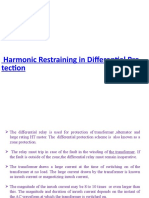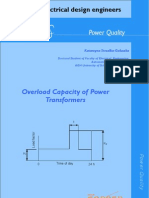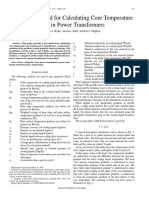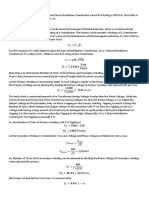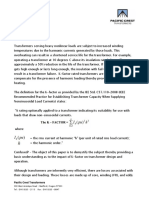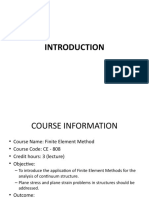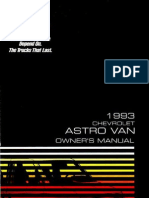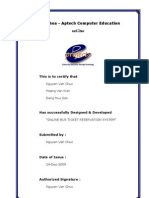Transformer Design Principles
Transformer Design Principles
Uploaded by
acport2809Copyright:
Available Formats
Transformer Design Principles
Transformer Design Principles
Uploaded by
acport2809Original Description:
Copyright
Available Formats
Share this document
Did you find this document useful?
Is this content inappropriate?
Copyright:
Available Formats
Transformer Design Principles
Transformer Design Principles
Uploaded by
acport2809Copyright:
Available Formats
TRANSFORMERS DESIGN PRINCIPLES
Objectives:
How to design power and distribution transformers in compliance with
international standards and the customer specifications, including a description
of all stages of the design process and the descriptions of the necessary
calculation tools.
The course is aimed at professionals working in the design area of transformer
factories as well as those who work in utilities and are responsible for the
specification, design review, acquisition, operation and maintenance of
transformers and reactors.
Contents:
The transformer design is studied from three fundamental points of view:
Dielectric dimensioning
Thermal dimensioning
Mechanical dimensioning
Among the numerical design tools to be described in the course are included
the Finite Element Method (FEM) and the minimizing of functions of several
variables with nonlinear constrains.
Detailed Program:
1. Introduction to the Design of Transformers
Customer Specifications
International Standards Framework (IEC, ANSI, CENELEC, etc.)
Disciplines Involved and Calculation Software Tools
2. Magnetic Circuit
Magnetic Materials
Construction Types
No-load losses Calculation
No-load current Calculation
Noise Level Calculation
Inrush Current Calculation
Overexcitation Phenomena
3. Windings
Materials (Conductors and Insulators)
Construction Types
Stabilisation and Pressing Process
Load Losses Calculation
Short Circuit Impedance
4. Short-circuit Reactance Calculation
Analytical Methods (Kapp, Roth, Rabins)
Numerical Methods (Finite Element Method)
Air-Core Reactance Calculation
5. Additional Losses Calculation (Eddy and Stray Losses)
Additional losses in windings due to axial and radial leakage magnetic
field (Eddy current losses)
Additional losses in windings due to circulation currents
Additional losses in tank and structural parts (Stray losses)
Effect of harmonics in additional losses
Temperature Correction of Load Losses and Short Circuit Impedance
6. Dielectric Design
Dielectric Tests
Insulating Materials
Resonances in Transformer Windings
Impulse Windings Response
Very Fast Transient Overvoltages (VFTO) Response
Electric Field Calculations
Safety Margins of Insulation System
7. Thermal Design
Core Temperature Calculation
Windings Temperature Calculation
External Cooling System (Radiators or Heat Exchangers)
Modeling using Thermal-Hydraulic Circuits (THNM)
Modeling using Computational Fluid Dynamics (CFD)
8. Short-circuit Design
Short-circuit Current Calculation
Thermal Effect of Short-circuit Currents
Short-circuit Forces Calculation
o Simple Formula Approach
o Roth Method
o Rabins Method
o Image Method
o Finite Element Method
Short-circuit Stress Calculation (IEC 60076-5:2006 Annex A)
Stabilization, drying and clamping of windings
9. Optimal Calculation - Minimizing of a function of several variables with
nonlinear constrains
Exterior Penalty Methods
Continuous Optimization
Discrete Optimization - Genetic Algorithms
10. Particularities of Reactor Design
Series and Shunt Reactors
2
Core Types and Vibrations
Additional Losses in the Winding
Variable Reactors with OLTC
Shunt Reactor Modeling in Switching Transients
Grounding Transformers
11. Mechanical Design of Tank
Constructional Types
Design of Tank Stiffeners
Conservator Design
Pressure in Sealed Tanks
Tank Integrity at Explosions
Seismic Behavior
12. Fundamentals of Finite Element Method applied to solve electromagnetic
problems
Variational Methods - Electrostatic Equation
Weighted Residuals Method - Magnetostatic Equation
Duration:
24 hours in 3 days (8 hours per day)
References:
The course was taught twice, in 1995 and 1997 at the Faculty of
Engineering of the University of Montevideo of the Republic of Uruguay as
"Professional Development Course"
The course was taught twice, in 2010 and 2012 at the Faculty of
Engineering of the University of Montevideo of the Republic of Uruguay as a
valid course for the Master of Engineering Degree Distribution and
Transmission
The course was taught in Costa Rica, in October 2014, for professionals of
ICE (Electrical Utility of Costa Rica)
The course will be taught in Norway, in March 2015, for professionals of
SINTEF (Largest independent research organization in Scandinavia),
Trondheim University and Statnett (Electrical Utility of Norway)
The course will be taught in Uruguay, in 2015, for professionals of UTE
(Electrical Utility of Uruguay)
You might also like
- NORSOK R-003 Safe Use of Lifting EquipmentDocument58 pagesNORSOK R-003 Safe Use of Lifting EquipmentMarios DiasNo ratings yet
- 15 - Pressure Relay For OLTC - (AKM - 35600 - Qualitrol)Document5 pages15 - Pressure Relay For OLTC - (AKM - 35600 - Qualitrol)Trần Minh TríNo ratings yet
- Hfe Pioneer vsx-921-k 1021-k Service rrv4182 enDocument9 pagesHfe Pioneer vsx-921-k 1021-k Service rrv4182 enmdbaddiniNo ratings yet
- Auto-Transformer Design - A Practical Handbook for Manufacturers, Contractors and WiremenFrom EverandAuto-Transformer Design - A Practical Handbook for Manufacturers, Contractors and WiremenRating: 4 out of 5 stars4/5 (2)
- Practical Guide to International Standardization for Electrical Engineers: Impact on Smart Grid and e-Mobility MarketsFrom EverandPractical Guide to International Standardization for Electrical Engineers: Impact on Smart Grid and e-Mobility MarketsNo ratings yet
- Construction Practice of Distribution TransformerDocument58 pagesConstruction Practice of Distribution TransformerRaj Kiran100% (3)
- 100MVA Design DetailsDocument10 pages100MVA Design DetailsAnonymous sAmJfcV100% (1)
- A Study of K-Factor Power TransformerDocument7 pagesA Study of K-Factor Power TransformerŽarko MočnikNo ratings yet
- CTC-Continuously Transposed ConductorDocument7 pagesCTC-Continuously Transposed ConductorSAGARNo ratings yet
- 25 - TransformerDesignDocument22 pages25 - TransformerDesignahmad shakeeb100% (1)
- Rogowski FactorDocument5 pagesRogowski FactorRiddhi GhoshNo ratings yet
- Designing of Amorphous Core Distribution Transformer and Comparison With CRGO Core Distribution TransformerDocument5 pagesDesigning of Amorphous Core Distribution Transformer and Comparison With CRGO Core Distribution TransformerIJMERNo ratings yet
- Study and Design of Power Transformer Under Short Circuit ConditionDocument83 pagesStudy and Design of Power Transformer Under Short Circuit ConditionMario Sitorus100% (4)
- Harnonics in TransformerDocument11 pagesHarnonics in Transformeranon_831041953100% (1)
- Books RefrenceDocument13 pagesBooks RefrencePradith SaiNo ratings yet
- Design of Distribution Transformer: Guaranteed LossesDocument8 pagesDesign of Distribution Transformer: Guaranteed Lossesprincedo marcelloNo ratings yet
- FEM Based No-Load Loss Calculation of Triangular W Ound Core TransformerDocument4 pagesFEM Based No-Load Loss Calculation of Triangular W Ound Core TransformerVictor Julián Fernández CarrazanaNo ratings yet
- CSP SystemDocument23 pagesCSP Systemvinay kumarNo ratings yet
- Thermal SimulationDocument40 pagesThermal SimulationAbdul HadiNo ratings yet
- Pwer TransformerDocument17 pagesPwer Transformerrossikada100% (2)
- Power TransformersDocument90 pagesPower TransformersMohammedSaadaniHassani100% (5)
- Transformers Yesterday, Today & TomorrowDocument48 pagesTransformers Yesterday, Today & TomorrowFaiz Ahmed100% (2)
- Transformer Database ReserchDocument8 pagesTransformer Database ReserchJignesh100% (1)
- Chapter 7 Overload Capacity of Power TransformersDocument10 pagesChapter 7 Overload Capacity of Power Transformerstenk_man100% (1)
- Transformer DesignDocument85 pagesTransformer DesignMr.BiplobNo ratings yet
- Calculating Core TemperatureDocument6 pagesCalculating Core TemperatureAnonymous sAmJfcVNo ratings yet
- On TransformerDocument20 pagesOn TransformerMurshedur Rahman100% (7)
- Transformer PolarityDocument4 pagesTransformer Polarityboy2959No ratings yet
- Analysis Using Various Approaches For Residual Life Estimation of Power TransformersDocument19 pagesAnalysis Using Various Approaches For Residual Life Estimation of Power TransformersJicheng PiaoNo ratings yet
- Controlled Shunt Reactors BrochureDocument13 pagesControlled Shunt Reactors BrochureFeras KharmaNo ratings yet
- Balanced Fault Calculation PDFDocument79 pagesBalanced Fault Calculation PDFvthiyagainNo ratings yet
- Transformer DeignDocument14 pagesTransformer DeignhamzaNo ratings yet
- Chapter 4: Design Methodology of Power TransformerDocument34 pagesChapter 4: Design Methodology of Power TransformerWellington AzziNo ratings yet
- ABB Manual 10E 02sDocument18 pagesABB Manual 10E 02sjaved shaikh chaandNo ratings yet
- Heat Dissipation in RadiatorDocument15 pagesHeat Dissipation in RadiatorkmulyadiNo ratings yet
- Losses in TransformerDocument2 pagesLosses in TransformerAdnan KhanNo ratings yet
- Transformer DesignDocument47 pagesTransformer Designsinergicus100% (2)
- Current TransformerDocument21 pagesCurrent Transformerbalaeee123No ratings yet
- Tan Delta Test - Loss Angle Test - Dissipation Factor TestDocument2 pagesTan Delta Test - Loss Angle Test - Dissipation Factor TesthusnainyasirNo ratings yet
- Autotransformer Tertiary Winding ConfigurationDocument2 pagesAutotransformer Tertiary Winding ConfigurationaocalayNo ratings yet
- 12 - Transformer ProtectionDocument40 pages12 - Transformer ProtectionSarthak Vats100% (3)
- Transformer Design OptimizationDocument6 pagesTransformer Design OptimizationOdhah AlShahraniNo ratings yet
- SIEMENS Transformer Winding SelectionDocument27 pagesSIEMENS Transformer Winding Selectionalex696No ratings yet
- A Review About Vector Group Connections in TransformersDocument7 pagesA Review About Vector Group Connections in TransformersMohamed Wahid100% (1)
- K-Factor and TransformersDocument6 pagesK-Factor and TransformersasssasasNo ratings yet
- Challenges and Strategies in Transformer Design PDFDocument75 pagesChallenges and Strategies in Transformer Design PDFaocalayNo ratings yet
- Info Iec61378-1 (Ed2.0) en PDFDocument9 pagesInfo Iec61378-1 (Ed2.0) en PDFtsrinivasan5083No ratings yet
- Calculations For Design Parameters of Transformer - Engineer ExperiencesDocument40 pagesCalculations For Design Parameters of Transformer - Engineer ExperiencesSamit DasNo ratings yet
- 05.learning by Failures A Transformer Case StudyDocument11 pages05.learning by Failures A Transformer Case Studyvikash100% (1)
- Amorphous MetalDocument2 pagesAmorphous MetalRamesh BabuNo ratings yet
- FLD 14Document32 pagesFLD 14guest100% (1)
- Mechanical Stresses in Transformer Windings : by E. BILLIG, DR - Tech., Member, FDocument17 pagesMechanical Stresses in Transformer Windings : by E. BILLIG, DR - Tech., Member, FleivajNo ratings yet
- Product Catalogue ThyssenkruppDocument32 pagesProduct Catalogue Thyssenkruppelisesalzy100% (1)
- 32 Specification P 82 81Document22 pages32 Specification P 82 81waqarNo ratings yet
- Transformer Design PresentationDocument75 pagesTransformer Design Presentationkrmurali2000No ratings yet
- CPC 100 Testrano 600 Appnote Dynamic Oltc Scan 2019 EnuDocument21 pagesCPC 100 Testrano 600 Appnote Dynamic Oltc Scan 2019 EnudanielsampermNo ratings yet
- MIST MSC-ME SyllabusDocument30 pagesMIST MSC-ME SyllabusSajidNo ratings yet
- 1 IntroductionDocument23 pages1 IntroductionSaeed RehmanNo ratings yet
- 1 Introduction Lecturenotes 1Document17 pages1 Introduction Lecturenotes 1akhilesh120No ratings yet
- Introduction To Modern Electrical Machine DesignDocument26 pagesIntroduction To Modern Electrical Machine DesignUSMANNo ratings yet
- EMD - Mod 1Document68 pagesEMD - Mod 1CelsiusNo ratings yet
- Filmora CrackDocument2 pagesFilmora CrackAxelia100% (1)
- TESAR Installation Use and Maintenance EngDocument20 pagesTESAR Installation Use and Maintenance EngPatran ValentinNo ratings yet
- F650man IDocument553 pagesF650man Iaurel_c12-1No ratings yet
- HR Policy ListDocument11 pagesHR Policy Listrkarjee100% (1)
- Building A Vacuum Forming TableDocument9 pagesBuilding A Vacuum Forming TableWil NelsonNo ratings yet
- Indian Remote Sensing Satellites and ApplicationsDocument14 pagesIndian Remote Sensing Satellites and ApplicationsASHISH UPADHYAYNo ratings yet
- Ultrafine PowderDocument90 pagesUltrafine PowderraeggaemanNo ratings yet
- Acxiom Case Study - MicrosoftDocument2 pagesAcxiom Case Study - MicrosoftsilentwarrioronroadNo ratings yet
- MEC 100 CHAPTER 4 (Engineering Estimation & Approximation)Document50 pagesMEC 100 CHAPTER 4 (Engineering Estimation & Approximation)HaFiy HaZimNo ratings yet
- Samil Power Inverter Catalogue BrochureDocument16 pagesSamil Power Inverter Catalogue BrochurevhgiaoNo ratings yet
- Sailor SP3110Document124 pagesSailor SP3110serNo ratings yet
- 5hp19eDocument2 pages5hp19eDevine LightNo ratings yet
- Ielts BookDocument137 pagesIelts BookAjay BediNo ratings yet
- TALHA BASHIR Sop (Politecnico Di Milano)Document3 pagesTALHA BASHIR Sop (Politecnico Di Milano)TalhaNo ratings yet
- OMD-507 O2 AnalyzerDocument2 pagesOMD-507 O2 Analyzerindra irawanNo ratings yet
- Size-For-Size Connections: Full End Load Performance Without CompromiseDocument5 pagesSize-For-Size Connections: Full End Load Performance Without CompromiseskodgeNo ratings yet
- 1993 Chevrolet Astro Owners ManualDocument345 pages1993 Chevrolet Astro Owners ManualastrolinNo ratings yet
- Simple Wep Crack (Aircrack-Ng)Document5 pagesSimple Wep Crack (Aircrack-Ng)Fernando GonzalezNo ratings yet
- E Project ReportDocument30 pagesE Project ReportLeo Beckham100% (1)
- Band ItDocument48 pagesBand ItCentral HydraulicsNo ratings yet
- Dragon Age Chargenmorph Compiler V1.1.0 - Mini Guide Coded by Terra - ExDocument6 pagesDragon Age Chargenmorph Compiler V1.1.0 - Mini Guide Coded by Terra - ExBrigit CollinsNo ratings yet
- Tachometer: Laser Photo/ContactDocument2 pagesTachometer: Laser Photo/Contactflavio torresNo ratings yet
- ADT ShortcutsDocument4 pagesADT ShortcutsgeethashriitNo ratings yet
- Design Knowledge MaterialDocument75 pagesDesign Knowledge MaterialAkin ErsozNo ratings yet
- A Study of Consumer Experience in Central MallDocument112 pagesA Study of Consumer Experience in Central MallNekta PinchaNo ratings yet
- IIS 10 - Install A Certificate - SSL Certificates - GoDaddy Help IN PDFDocument2 pagesIIS 10 - Install A Certificate - SSL Certificates - GoDaddy Help IN PDFMandeep KumarNo ratings yet
- 800 10425Document2 pages800 10425slymnNo ratings yet
- MCB For Protection - Acti9 Ic60 - A9F74463Document3 pagesMCB For Protection - Acti9 Ic60 - A9F74463lazarNo ratings yet














